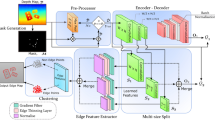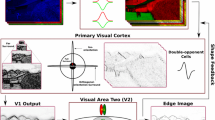Abstract
In this paper, the authors address the problem of edge-perception for its applications to vision-feedback control in robotic systems.
In natural vision, the recognition of objects takes place through the process consisting of ‘eye system’, ’neural networks’ and ‘cognition’. The cognitive process, in turn yields a phenomenon known as perception. This is the phenomenon of perception of physical attributes, such as edges, color and texture, etc., which is responsible for the recognition of objects through the natural vision processes.
In this paper, we make an attempt to postulate the theory of perception for gray-level images. The gray-level images, when going through the cognitive and perception processes, are contaminated by the uncertainty; here we call it ‘cognitive uncertainty’.
The studies in this paper are confined to the phenomenon of edge-perception for two-dimensional gray-level images, however, these studies can be extended to other types of visual attributes both in two-dimensional and three-dimensional spaces. Indeed, the perception of these attributes, which attempts to emulate the human vision system, may help in the design of a truly robust computer vision-feedback control system for robotic applications.
Similar content being viewed by others
Explore related subjects
Discover the latest articles, news and stories from top researchers in related subjects.References
GonzalezR.C., and SafabakhshR., Computer vision techniques for industrial inspection and robot control: A tutorial, in Tutorial on Robotics, (ed. C.S.G.Lee, R.C.Gonzalez, and K.S.Fu) IEEE Computer Society Press, New York (1983), pp. 300–324.
Gupta, M.M., Knopf, G., and Nikiforuk, P.N., Computer vision with fuzzy edge perception, IEEE International Symposium on Intelligent Control, Jan. 18–20, Philadelphia (1987).
GuptaM.M., KnopfG.K., and NikiforukP.N., Edge perception using fuzzy logic, in Fuzzy Computing: Theory, Hardware and Applications, (eds. M.M.Gupta and T.Yamakawa), North-Holland, Amsterdam (1988), pp. 35–52.
NitzanD., Development of intelligent robots: achievements and issues, IEEE J. Robotics and Automation, RA-1, 3–13 (1985).
LevineM.D., Vision in Man and Machine, McGraw-Hill, New York (1985).
JarvisR.A., Machine vision—a review, J. Electrical and Electronics Engineering (Australia—IE Aust. and IREE Aust.) 6, 100–115 (1986).
KandelE.R., and SchwartzJ.M., Principles of Neural Science, Elsevier, New York (1985).
TanimotoS., and KlingerA., Structure Computer Vision, Machine Perception Through Hierarchical Computation Structures, Academic Press, New York (1980).
ZadehL.A., Outline of a new approach to the analysis of complex systems and decision process, IEEE Trans. Syst. Man. Cybern SMC-3 28–41 (1973).
KaufmanA., and GuptaM.M., Introduction to Fuzzy Arithmetic: Theory and Applications, Van Nostrand, New York (1985).
GuptaM.M., KnopfG.K., and NikiforukP.N., Sinusoidal-based cognitive mapping functions, in Fuzzy Logic in Knowledge-Based Systems, Decision and Control, (eds. M.M.Gupta and T.Yamakawa), North-Holland, Amsterdam (1988), pp. 69–92.
RagadeR.K., and GuptaM.M., Fuzzy set theory: introduction, in Fuzzy Automata and Decision Processes (eds. M.M.Gupta, G.N.Saridis and B.R.Gaines), North-Holland, New York (1977), pp. 105–131.
CastlemanK.R., Digital Image Processing, Prentice-Hall, Englewood Cliffs, New Jersey (1979).
Author information
Authors and Affiliations
Rights and permissions
About this article
Cite this article
Gupta, M.M., Knopf, G.K. Theory of edge perception for computer vision feedback control. J Intell Robot Syst 2, 123–151 (1989). https://doi.org/10.1007/BF00238685
Received:
Issue Date:
DOI: https://doi.org/10.1007/BF00238685




